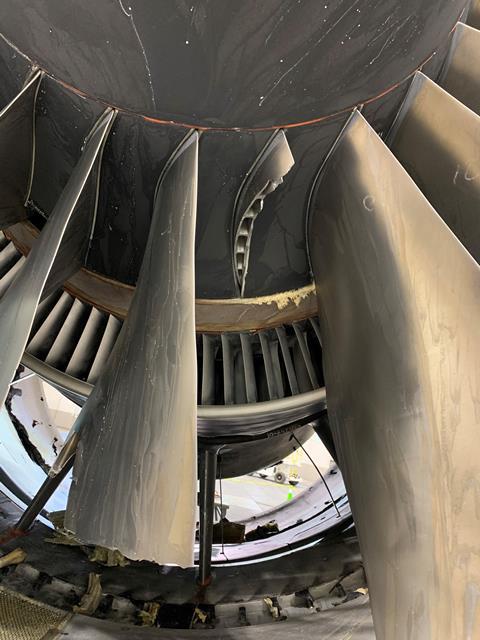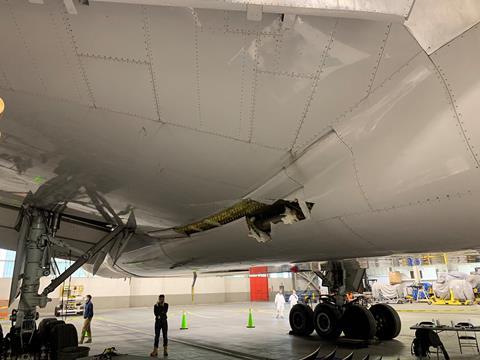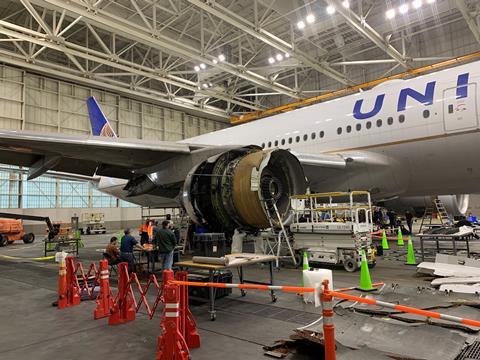After a preliminary onsite exam, the National Transportation Safety Board (NTSB) says the engine failure on a United Airlines aircraft on 20 February was likely caused by metal fatigue.
Two fan blades of the Boeing 777-200’s right-hand Pratt & Whitney PW4077 engine were severed, one at the root and one in mid-span. The aircraft with the tail number N772UA had just departed from Denver International airport and was bound for Honolulu as UA328.
The fan blade that was severed at the root “indicates damage consistent with metal fatigue,” NTSB chairman Robert Sumwalt says on 22 February. “This piece is being flown on a private jet tonight to a Pratt & Whitney lab where it will be examined tomorrow under the supervision of NTSB investigators.”

A second fan blade, which looks from photographs to have been severed mid-span, “is consistent with being struck with the other fan blade” in what the NTSB calls “overload damage”.
“It probably got hit as the other piece was separated,” Sumwalt says.
The engine has 22 fan blades. One blade was “embedded in the engine containment ring at about the one o’clock position.” Sumwalt adds. The other was recovered from a soccer field in Broomfield, Colorado. The aircraft rained debris on neighbourhoods below as it returned to Denver for an emergency landing.
Sumwalt added that the safety organisation will be examining the blades for “crack arrest marks”, which he compared to marks in the sand similar to when a tide comes in or goes out on a beach, in order to determine how long the blades had been damaged.
“This has to be done in our lab where we can measure and count the number of crack arrest marks… [and] we can come up with a pretty accurate number of when that fatigue crack was initiated,” he says.
In addition to the shredded engine, the aircraft has a large gash in the composite fibreglass fairing at the wing root, where the wing joins the fuselage. This was likely punctured by a piece of flying metal, the NTSB says. It is still unclear how close that may have come to damaging the pressurised cabin.

“There were dings and nicks in other places on the wing but there was no structural damage,” Sumwalt adds.
Questions remain as to why the engine cowling tore off the aircraft, and the fire continued to burn inside the engine after it was shut off, as video taken from inside the aircraft and later posted to social media show.
“We do not expect a cowling to separate like that. We certainly want to understand what caused that cowling to separate in this case,” he says. “As far as the fire, we have indications that the fuel to the engine was turned off so we will be looking to see what may have continued to propagate a fire.”
After the initial investigation, Sumwalt says that the NTSB is currently not defining the incident as an uncontained engine failure.
“We, according to our strictest definition, do not consider this to be an uncontained engine failure. For the public it doesn’t matter. It was still an event that we don’t like to see,” he says.

Earlier in the day the US Federal Aviation Administration ordered emergency inspections of some Pratt & Whitney PW4000-powered Boeing 777-200s in response the in-flight incident.
The event also prompted United Airlines and Japan to ground its PW4000-powered 777s.
Airlines in only three countries – the USA, Japan and South Korea – operate that type with these engines, the US regulator said. Many of the jets were recently removed from service in response to the industry downturn as a result of the coronavirus.
Two other PW4000 failures in recent years involved a JAL 777 in December 2020 and a United 777 over the Pacific Ocean in 2018. Investigators also traced the 2018 incident to a blade failure.
Cirium fleets data shows that six airlines globally have 60 in-service 777s with PW4000s, with 67 aircraft in storage. Operators comprise All Nippon Airways, Asiana Airlines, Japan Airlines, Jin Air, Korean Air, and United Airlines.


























